|
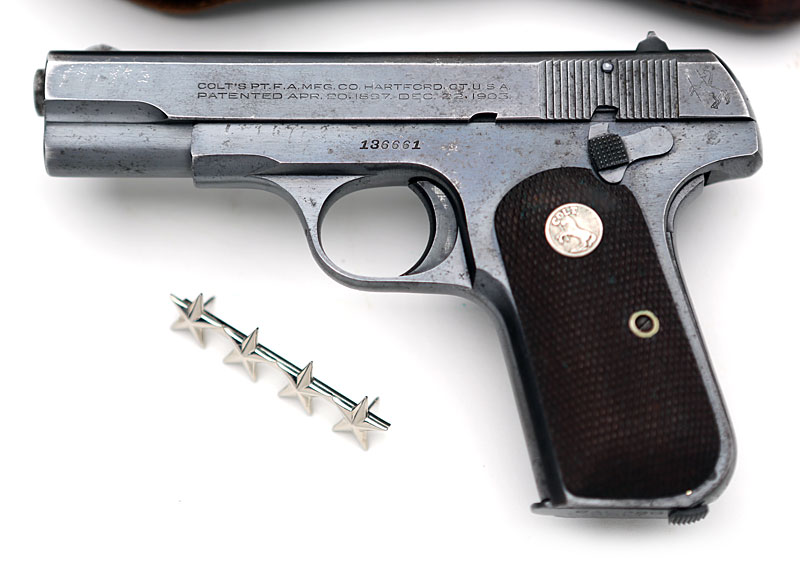
Colt Model 1908 Pocket Hammerless .380 ACP pistol serial number 136661
was issued
issued to General Samuel Egbert Anderson. According to
Rock Island Arsenal records, Brigadier General S.E. Anderson
was issued a .380 caliber pistol, and no serial number was
recorded by RIA. In 1960, Gen. Anderson gave his
General Officer pistol as a gift to his West Point
classmate, colleague and friend Colonel Stuart G. McLennan.
Both men were West Point Class of 1928.
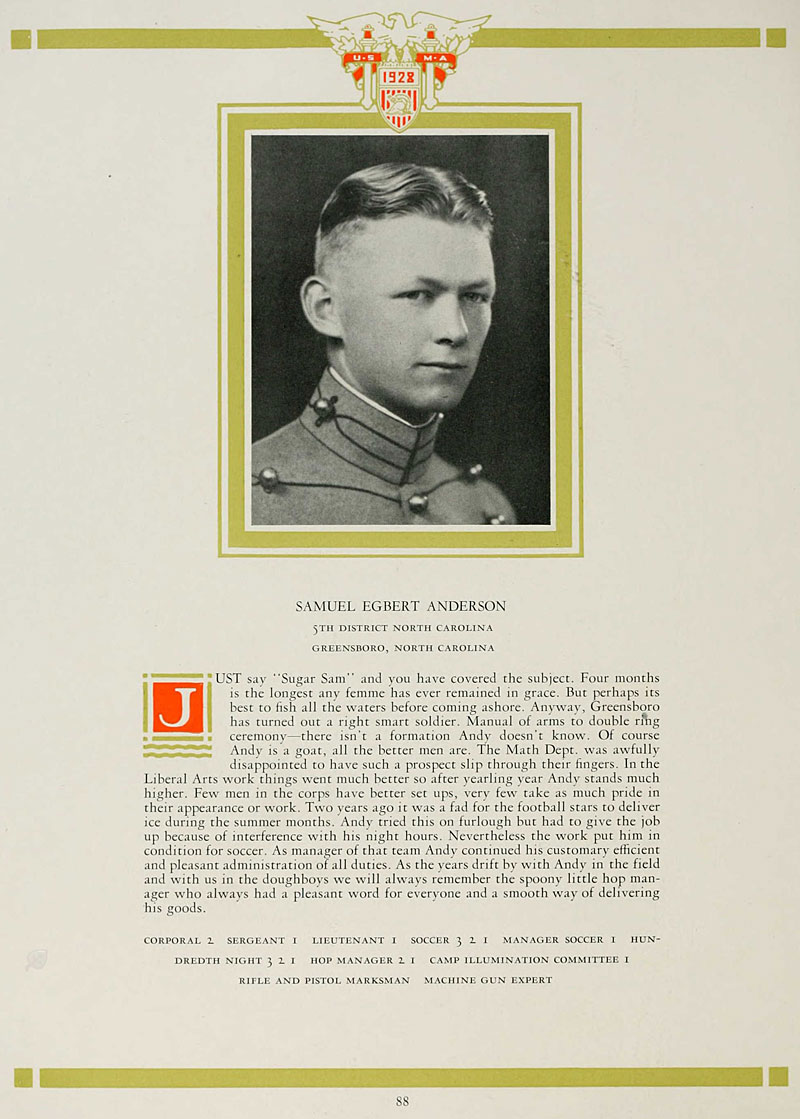
Samuel Egbert Anderson, USMA Class of
1928.
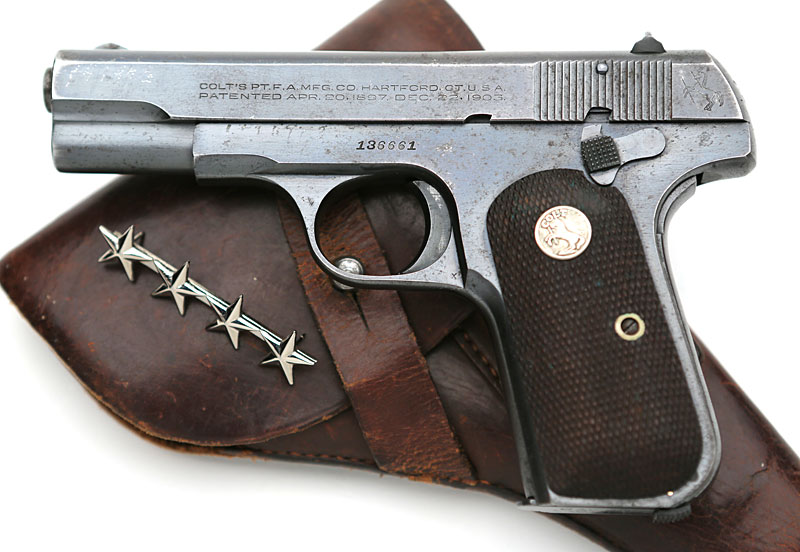
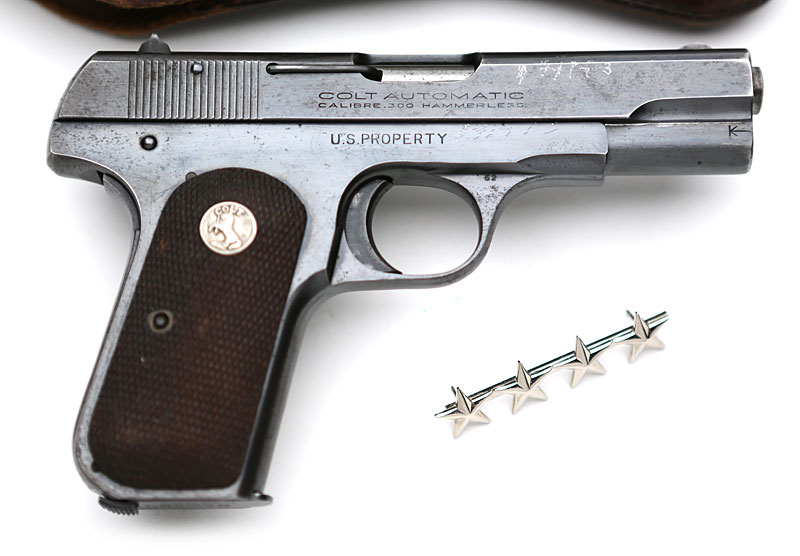
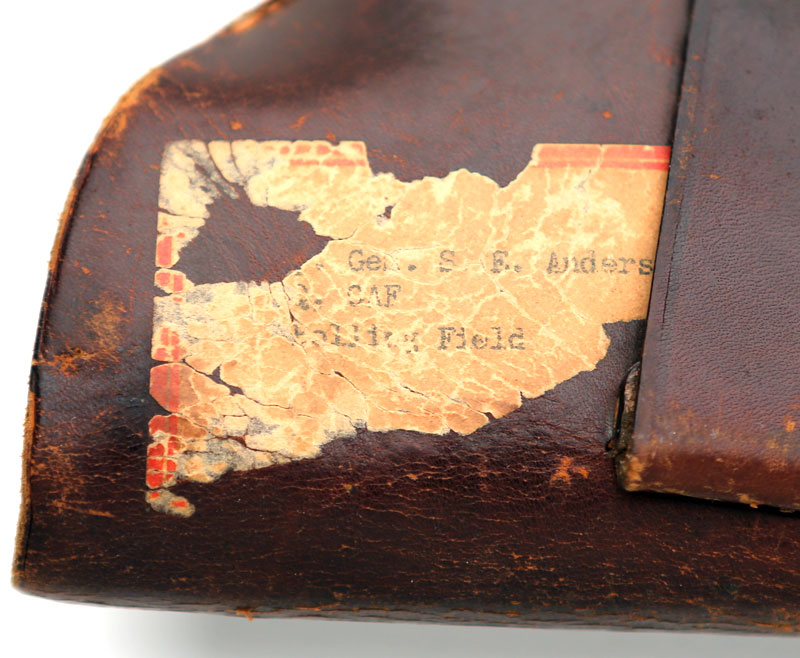
Accompanying this pistol are one magazine and leather
holster. There is a label on the back of the holster that
says "Maj. Gen S.E. Anderson, HQ CAF, Bolling Field".
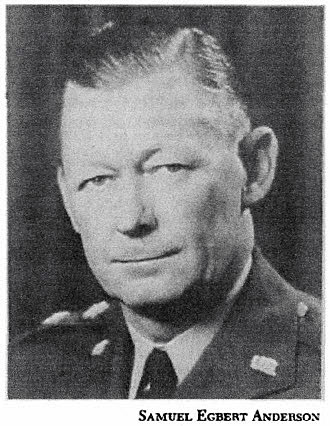 General Samuel E. Anderson was USMA Class of 1928. The
pistol was likely his when he was Chief of Staff,
Continental Air Forces (CAF) at Bolling Field in May 1945.
(CAF was formed on Dec 13, 1944 and renamed Strategic Air
Command on Mar 21, 1946.) He was then promoted to Lientenant
General and assumed command of 5th Air Force in May 1953;
promoted to General in March 1959; commanded Air Material
Command (AMC) from 1959-1961; retired in 1963; and died in
1982. General Samuel E. Anderson was USMA Class of 1928. The
pistol was likely his when he was Chief of Staff,
Continental Air Forces (CAF) at Bolling Field in May 1945.
(CAF was formed on Dec 13, 1944 and renamed Strategic Air
Command on Mar 21, 1946.) He was then promoted to Lientenant
General and assumed command of 5th Air Force in May 1953;
promoted to General in March 1959; commanded Air Material
Command (AMC) from 1959-1961; retired in 1963; and died in
1982.
Samuel Egbert
Anderson
NO. 8398 CLASS OF
1928
Died 12 September 1982 at Fort Sam
Houston Hospital, San Antonio, Texas, aged 76 years.
Interment: United States Air Force
Academy,
Colorado Springs, Colorado
As CADETS WE KNEW HIM as Sugar Sam Ė a
handsome, intelligent, suave and debonair young Southern
Gentleman. But this does not tell all. A few excerpts from
beneath his picture in our 1928 HOWITZER give a better
indication of his potential as a distinguished officer in
our Armed Forces - "Greensboro has turned out a right smart
soldier.... Few men in the Corps have better setups, very
few take as much pride in their appearance or work ... his
customary efficient and pleasant administration of all his
duties ... who always had a pleasant word for everyone and a
smooth way of delivering his goods."
A few months after graduation Sam
married Frances Marjorie Adams of Bronxville, New York. They
honeymooned en route to the Air Corps Flying School, San
Antonio, Texas, their first station.
Subsequent to graduation they were
stationed at Mitchel Field (1929-32). Air Corps Technical
School (Engineering) at Chanute Field (1932-33). Kelly Field
(flight instructor) (1933-39). Hawaii (1939-41), and at
Langley Field in mid 1941.
It was in the fall of 1941 when Sam's
military career took off like a rocket! He was transferred
to the Air Corps Headquarters in Washington. D.C. and
shortly thereafter to the War Department General Staff.
In March of 1942 he was ordered by
General Marshall on a special mission to the Southwest
Pacific reporting to General MacArthur. While there he flew
several combat missions, and for one he was awarded the
Silver Star for gallantry in action. Prior to that he had
already pioneered the island hopping air route from our West
Coast to Australia, which was used by thousands of our
aircraft during World War II.
In early 1943 he was ordered to England
as a colonel to command the 3d Bomber Wing of the 8th Air
Force, and in October was to brigadier general at age 36.
Ten of the eleven units in his command won the Presidential
Citation. It was not unusual for his command to have a
thousand or more bombers en route to their targets at the
same time.
He was then awarded the Distinguished
Flying Cross, promoted to major general and assumed command
of the 9th Bomber Command of the 9th Air Force.
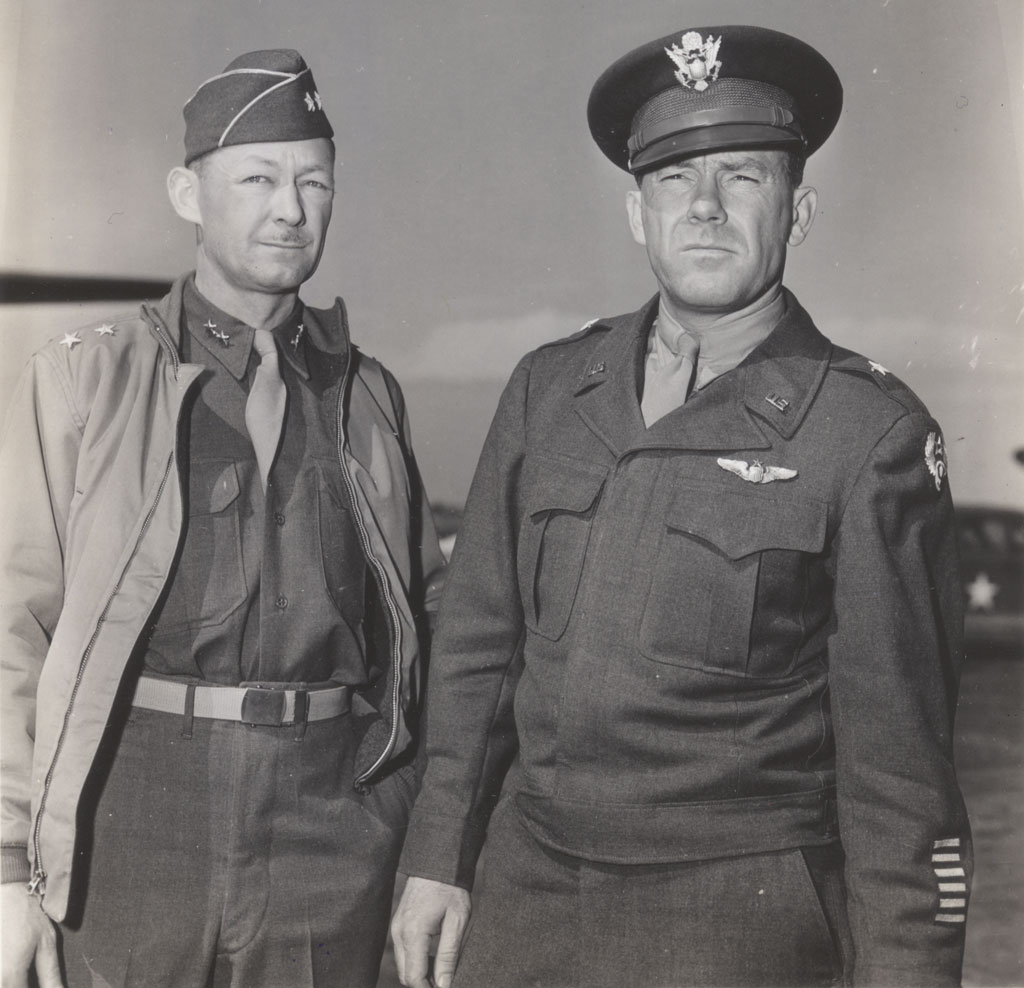
Radio Commentators Tour War Fronts.
Juvencourt Airfield, France. 11 Apr. 1945. Maj. Gen. Sam
Anderson, Commanding General 9th Bombardment Division of the
9th Air Force left and Brig. Gen. Edwin J. Backus,
Commanding General 97th Wing of 9th Air Force.
These last two commands demanded the
utmost in intelligence and military Leadership. His commands
as a whole were outstanding. They participated in the
campaign against the German Air Force in France and the Low
Countries, July 1943 to December 1943; against the German
V-1 and V-2 missile launching sites in France and the LOW
Countries, December 1943 to May 1944. The Commanding General
of the Allied Tactical Air Force officially designated the
9th Bomber Command as the most effective command employed against these missile
launching sites. In addition all highway and railroad
bridges across the Seine between LeHavre and Paris were
destroyed. His Bomber Command completed interdiction of the
Ardennes Bulge from late December 1944 to early January
1945, and effective interdiction of the Remagen bridgehead
which prevented German reinforcements from arriving in time
to dislodge our forces that had already crossed the Rhine.
It also participated in the isolation of the Ruhr which
resulted in the capture of approximately 350,000 German
troops and in active and effective support of front line
troops from the Normandy bridgehead until the end of the
War. He worked day to day with General Patton and the Third
Army. Apropos of General Patton's headlong dash eastward
after the breakout, he is reported to have been asked one
day-''What about your flanks?" His reported reply - "The 9th
Tactical Air Force and Bomber Command are my flanks and my
supply line." Again Sam was there to deliver his share of
the goods.
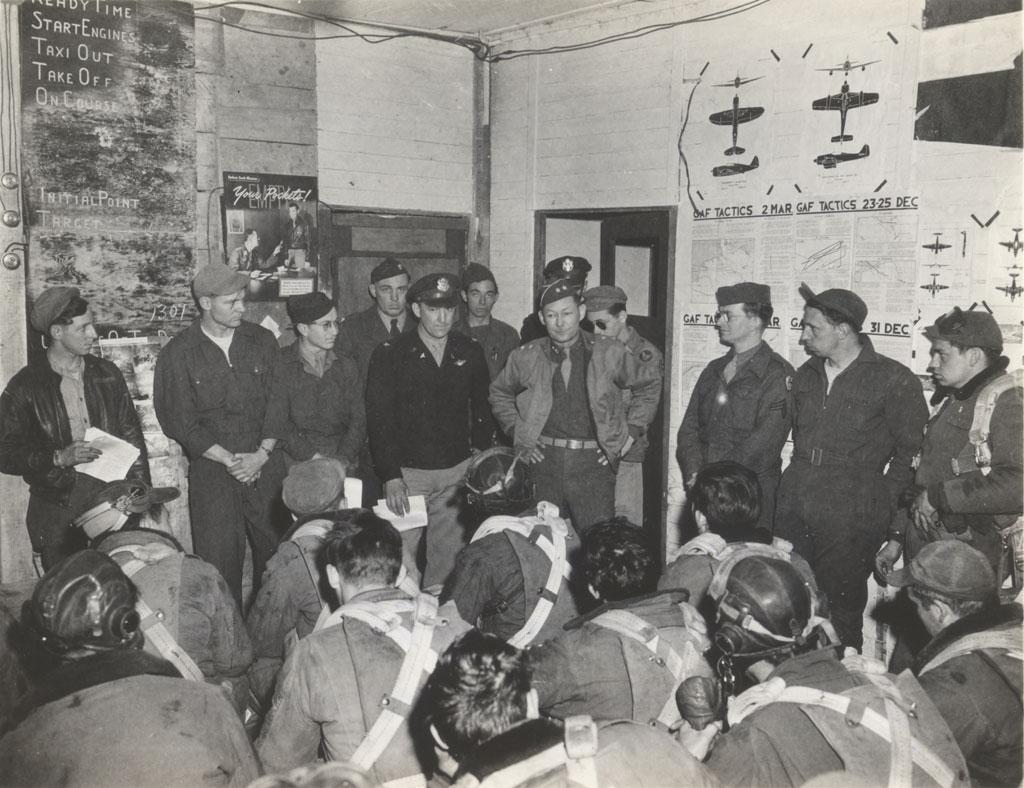
Radio Commentators Tour
War Fronts. Juvencourt Airfield, France. 11 Apr. 1945. Maj.
Gen Sam Anderson Commanding the 9th Bombardment Division
talking to crew members just after returning from mission of
bombing Ordnance Depot at Nuremburg.
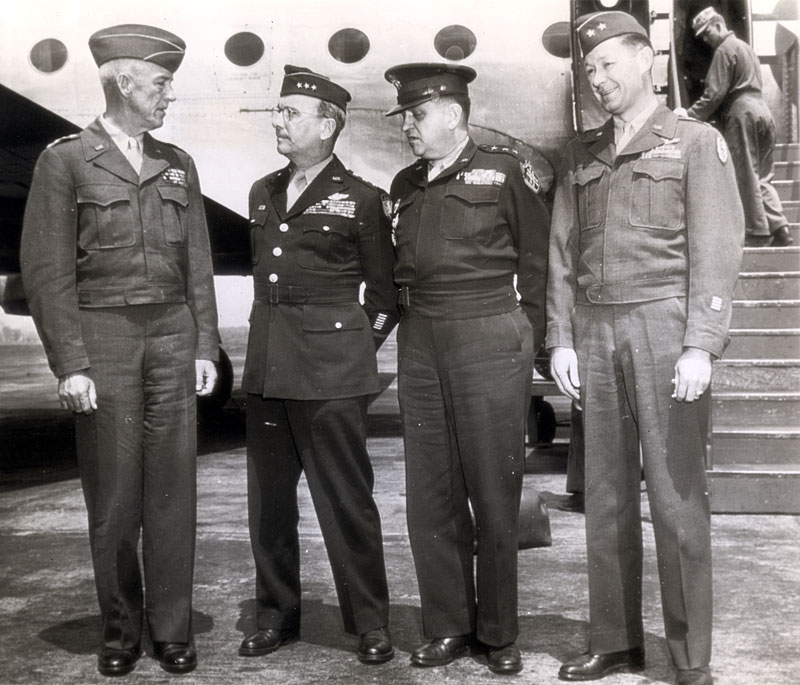
(WX8) WASHINGTON, May
25, 1945 -- GEN HODGES ARRIVES IN WASHINGTON --- Gen.
Courtney H. Hodges, (LEFT) U.S. First Army Commander, chats
with other veterans of European battles upon arrival at
National Airport here today. Others are (L to R) Lt.
Gen. Lewis H. Bereton, First Allied Airborne Army Commander,
Lt. Gen. Walton H. Walker, 20th Army Corps, and Maj. Gen.
Samuel E. Anderson of the 9th AAF Bomber Command (AP
Wirephoto)(F61600STF-HB45)
When World War II ended he was briefly
assigned as Chief of Staff of the Continental Air Force. A
few months later he was assigned to the Pentagon and served
for the next two years as a member of the Joint Strategic
Survey Committee of the Joint Chiefs of Staff, and the
Steering Committee of the Joint Chiefs of Staff.
From 1947 to 1950 he served as Deputy
Chief of Staff Plans and Operations, United States Air
Force.
His next assignment at Carswell Air
Force Base as Commander of the 8th Air Force in 1950 was
another demanding and challenging one. Here he trained the
officers and men of the 8th Air Force in the new B-36
bombers, the only aircraft we had with an intercontinental
nuclear capability. He again delivered the goods.
In April 1953 he was promoted to
Lieutenant General and was named Commander of the Fifth Air
Force in Korea. From May until August 1953 his command flew
more sorties than at any other time of the Korean War and
aided significantly in bringing that war to an end.
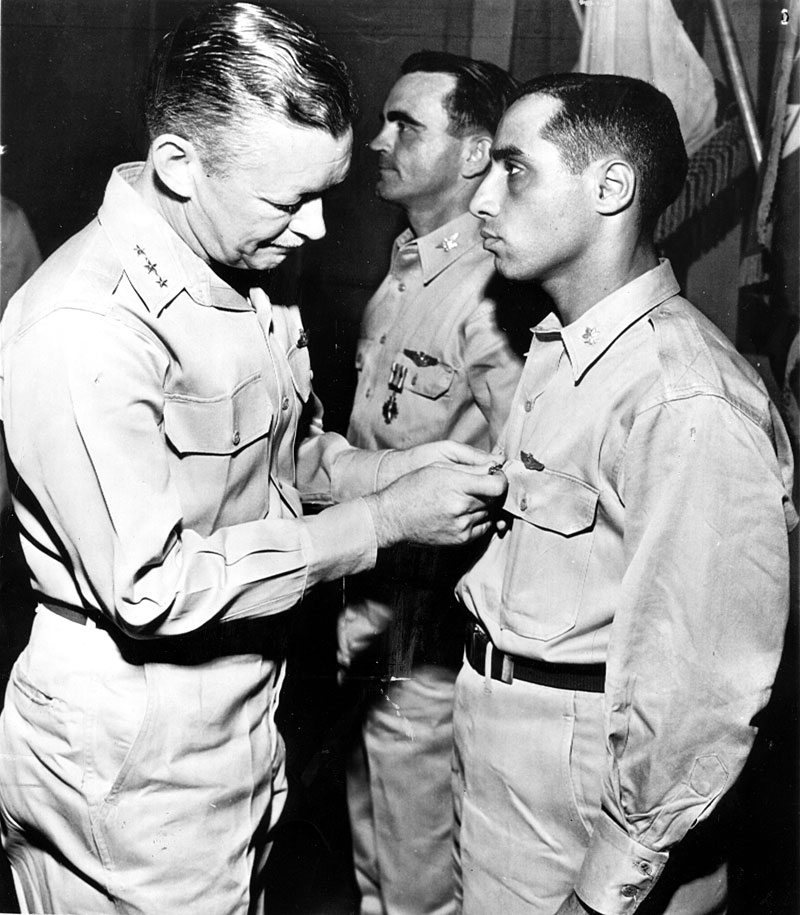
Lt. Gen. Samuel Anderson
presents awards to Col. James K. Johnson and
Major James Jabara (First American Jet Ace in history)
who received the 4th, 5th and 6th Oak Leaf Clusters to the
Distinguished Flying Cross. (Associated Press Wirephoto - 21
July 1953)
In 1954 he moved into what was at that
time one of the most demanding and responsible assignments
of the day. He was named Director of the Weapons System
Evaluation Group (WSEG). In this capacity it was his duty to
evaluate America's future defense needs and recommend the
weapons systems to meet them in the years to come. He worked
with experts in all branches of the sciences and military
services. Technology was moving so swiftly that time was of
the essence. These experts studied, reviewed, digested and
assimilated all weapons ideas from the prosaic to the most
revolutionary. As Director of WSEG, his wisdom, leadership
and recommendations are being confirmed to this day.
In 1957 he was assigned command of the
Air Research and Development Command (ARDC), then located in
Baltimore, Maryland. Shortly thereafter he moved his command
to Andrews Air Force Base. In 1957, when Russia launched the
first Sputnik, ARDC was called upon to produce a reply. In
less than a year the United States launched its first
satellite.
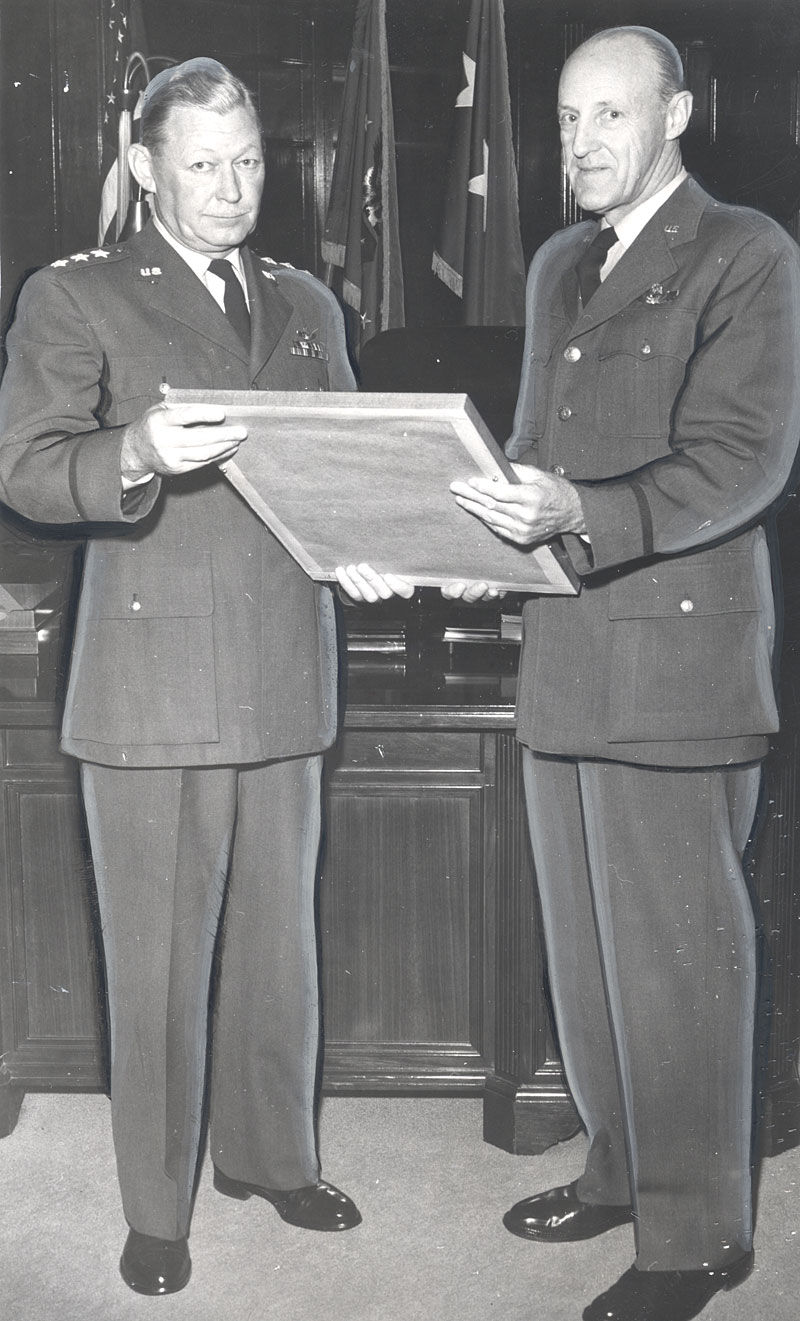
Lt. Gen. Samuel E.
Anderson and Maj. Gen Albert C. Boyd - 06 November 1957.
Two years later Sam was named
Commanding General of the Air Materiel Command and with it
came his 4th star. It was a very large command with 187,000
civilian and military personnel worldwide and assets of
about thirty million dollars. He introduced new methods of
procurement, storage and distribution of his costly
inventory and thereby saved the Air Force and the United
States government untold millions of dollars.
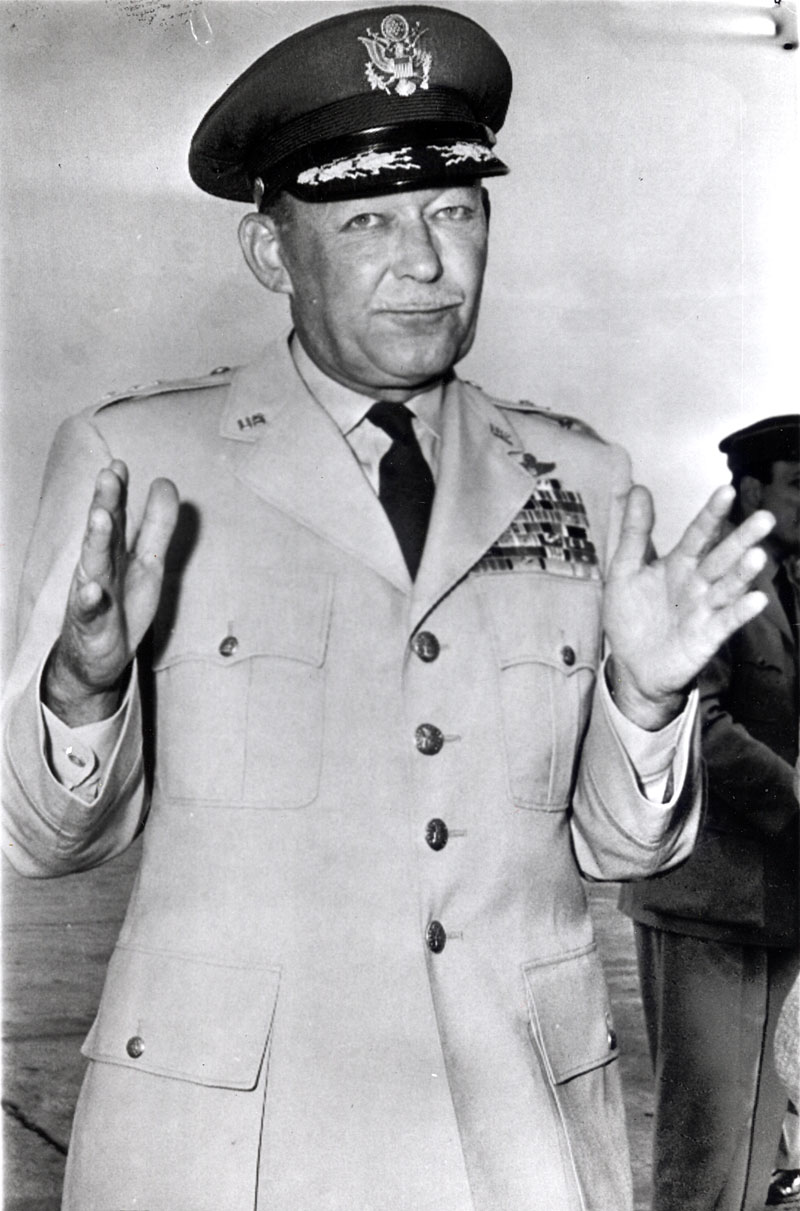
(WX32) WASHINGTON, JUNE
10, 1958 - TELLS OF MOON SHOT PLANS - Lt. Gen. S.E.
Anderson, U.S. Air Force chief of research and development
gestures as he talks with newsman at Andrews Air Force Base
near here tonight after a flight from Milwaukee, Wis., where
he announced earlier today, the Air Force would shoot at the
moon three times this year. Roy W. Johnson, director of the
Defense Department's Advanced Research Projects Agency,
later told newsmen that there would be no attempt to make a
direct impact with the moon and no final decision had been
made as to dates for the moon shot. In explanation
here tonight, Anderson said his command and Johnson's office
have "good relations" and that he was naming only a planning
date. (AP Wirephoto)(lj32125stfHB)1958.
In August 1961 he was named Air Deputy
in Supreme Headquarters, Allied Powers Europe (SHAPE), one
of the most senior officers in Europe. His responsibility
was great -- to command and guide 15 Allied Air Forces in
the North Atlantic Treaty Organization.
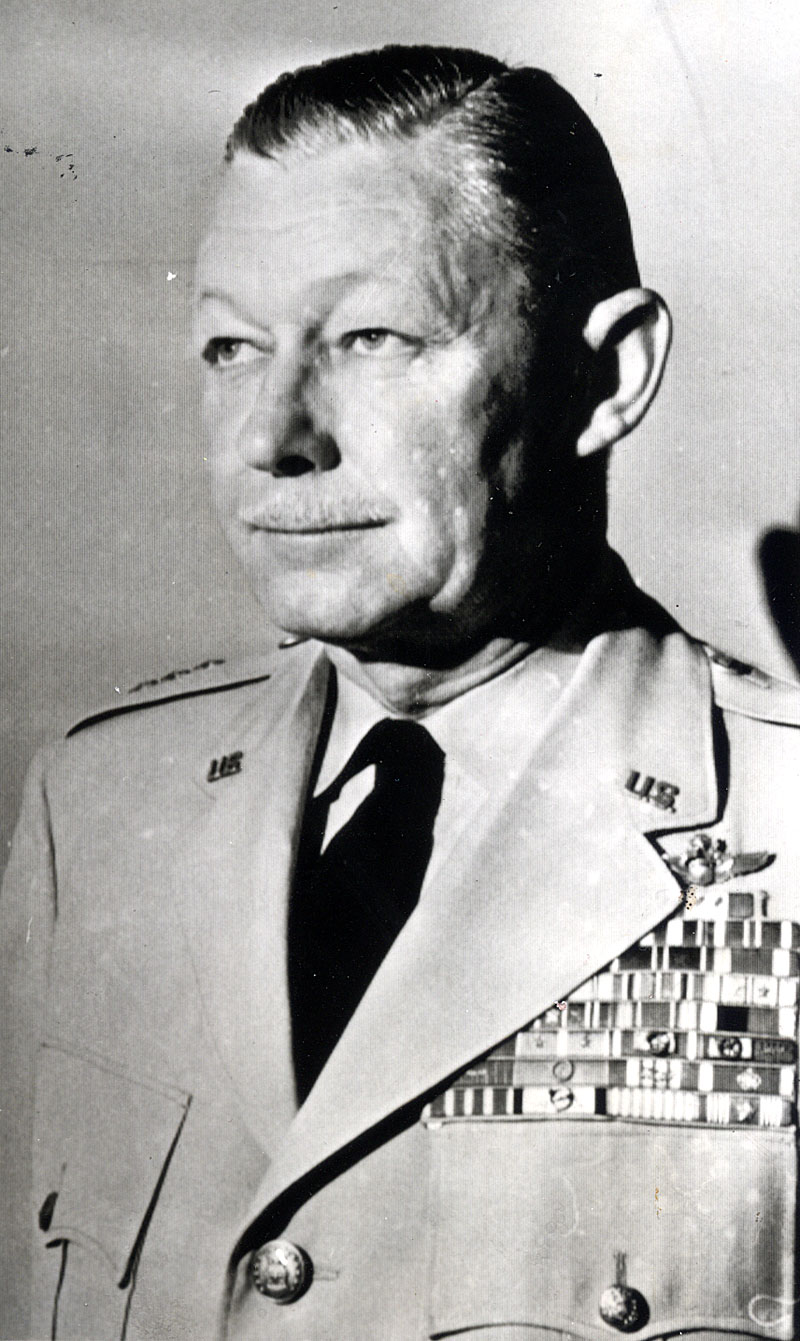
Lt. Gen. Samuel E.
Anderson (10 June 1958)
In addition to the Silver Star and
Distinguished Flying Cross, his decorations include the
Distinguished Service Medal with three oak leaf clusters.
Bronze Star Medal and Air Medal. His foreign decorations
were the British Order of the Bath, the Croix de Guerre from
France, Belgium and Luxembourg, and the Korean Taeguk
Distinguished Military Service Medal with Star.
He retired in 1963 and worked for
several years in civilian industry.
Samíl, as he was known to his close
friends, was a kindly and generous man. For example when he
was in Korea commanding the 5th Air Force he
heard an eleven year old Korean boy playing the piano. He
recognized the boy's talent, ability and potential.
Subsequently he was instrumental in bringing this boy to the
United States and entering him in the Julliard School of
Music in New York City. Samíl was right again. The Korean
boy, now a young man, a United States citizen, is Professor
of Music at North Texas State University and concertizes
worldwide.
This story would not be complete
without more about his devoted wife, affectionately known as
Sally to the multitude of their friends around the world.
For fifty-three years she stood by lovingly and faithfully
thru the trials and tribulations and the joys and sorrows of
life in their service to our country. She now lives in San
Antonio, Texas. They moved to San Antonio in 1978. Saml's
health was deteriorating, but he was a great game player to
the end. He loved to win, but if the cards went against him
he lost with a smile and the dignity of a gentleman. So now
Samíl It is time to say farewell. We were privileged to have
served with you. We shall all miss you, a true son of West
Point with faith in and fidelity and devotion to our country
and our Alma Mater. You lived by our code Ė Duty, Honor,
Country and served our beloved country with distinction --
truly a great officer and gentleman.
In the words of our Alma Mater: "May it
be said Well Done. Be Thou at Peace."
-- S.G. McL. [Colonel Stuart G.
McLennan]
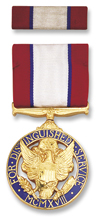 |
Army Distinguished Service Medal The President of the United States of America, authorized by Act of Congress
July 9, 1918, takes pleasure in presenting the Army Distinguished Service Medal
to Major General Samuel Egbert Anderson (ASN: 0-17244/92A), United States Army
Air Forces, for exceptionally meritorious and distinguished services to the
Government of the United States, in a duty of great responsibility during the
period from May 1945 to February 1946. General Anderson, as Chief of Staff,
Continental Air Forces, was responsible for the development of plans and
policies which resulted in reorganizing, retraining, re-manning and re-equipping
of combat and service organizations to meet the Army Air Forces redeployment
programs. Later as Army Air Forces Member of the Joint Strategic Survey
Committee, General Anderson applied his wide knowledge and experience in
providing valuable assistance to the Joint Chiefs of Staff in arriving at
decisions of highest importance, implementing the field of long range strategy
and policy. He assisted in providing the means for negotiating peace settlements
in Europe and Asia and his advice to military representatives of the United
States in the United Nations Organization has proven invaluable. General
Anderson's distinguished services have reflected great credit upon himself and
the Armed Forces of the United States.
General Orders: War
Department, General Orders No. 48 (1945)
Action Date: May
1945 - February 1946
Service: Army
Air Forces
Rank: Major
General
|
 |
Army Distinguished Service Medal
Awarded for actions during the World
War II
The President of the United States of America takes pleasure in presenting a
Bronze Oak Leaf Cluster in lieu of a Second Award of the Army Distinguished
Service Medal to Major General Samuel Egbert Anderson (ASN: 0-17244/92A), United
States Army Air Forces, for exceptionally meritorious and distinguished services
to the Government of the United States, in a duty of great responsibility. Major
General Anderson, as Chief of Staff, Continental Air Forces, and later as Army
Air Forces Member of the Joint Strategic Survey Committee, performed meritorious
and distinguished service in the United States from May 1945 to May 1946. In the
development of plans and policies for the reorganization, re-training,
re-manning and re-equipping of the combat and service organizations incident to
the Army Air Forces re-deployment program, he demonstrated an exceptional
knowledge of operational techniques, training problems and manning requirements.
He then further supplied his broad knowledge and experience in the field of
aviation, in rendering valuable assistance to the Joint Chiefs of Staff and in
skillfully advising United States military representatives in the United Nations
Organization. By his distinguished service, General Anderson contributed greatly
to the operations and continued success of the Army Air Forces.
General Orders: War
Department, General Orders No. 134 (1946)
Action Date: May
1945 - May 1946
Service: Army
Air Forces
Rank: Major
General
|
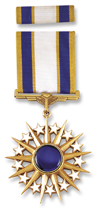 |
Air Force Distinguished Service Medal
Awarded for actions during the Korean
War
The President of the United States of America takes pleasure in presenting a
Second Bronze Oak Leaf Cluster in lieu of a Third Award of the Distinguished
Service Medal (Air Force) to Lieutenant General Samuel Egbert Anderson (ASN:
0-17244/92A), United States Air Force, for exceptionally meritorious and
distinguished services to the Government of the United States, in a duty of
great responsibility as Commander, FIFTH Air Force, from 1 June 1953 to 1 June
1954. At the beginning of that period, General Anderson, through intelligent,
resourceful leadership and astute deployment of tactical air power under the
most restrictive operational conditions, directly influenced the accomplishment
of United Nations objectives in Korea during a period of heightened enemy
activity. By maintaining continuous air supremacy throughout the battle zone, by
providing unprecedented close support to United Nations combined ground
operations, and by the judicious selection and destruction of lucrative enemy
targets, General Anderson was highly instrumental in inducing the enemy to
conclude an armistice. General Anderson consistently maintained his air arm at a
peak of operational effectiveness and flexibility, enabling it to effectively
counter the enemy's desperate efforts during the last weeks of hostilities.
Particularly noteworthy were General Anderson's achievements in connection with
rendering North Korean airfields unserviceable just prior to the effective date
of the Armistice Agreement concurrent with the destruction of record numbers of
enemy MiGs in aerial combat. After the Armistice Agreement, General Anderson
redirected the efforts of his entire command with emphasis on maintaining a high
state of watchful readiness and operational effectiveness. Through his astute
judgment, keen leadership and unselfish devotion to duty, General Anderson made
a significant contribution to the success of United Nations operations in Korea,
and reflected great credit upon himself, the FAR EAST Air Forces and the United
States Air Force.
General Orders: Department
of the Air Force, General Orders No. 25 (1954)
Service: Air
Force
Rank: Lieutenant
General
|
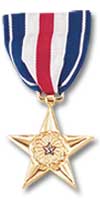 |
Silver Star
Awarded for actions during the World
War II
The President of the United States of America,
authorized by Act of Congress July 9, 1918, takes
pleasure in presenting the Silver Star to Colonel
(General Staff Corps) Samuel Egbert Anderson (ASN:
0-17244/92A), United States Army Air Forces, for
gallantry in action in the vicinity of Port Moresby
and Salamaua, New Guinea, on 9 June 1942. While on a
mission of obtaining information in the Southwest
Pacific Area, Colonel Anderson, in order to obtain
personal knowledge of combat conditions, volunteered
as an observer on a hazardous aerial combat mission
over hostile positions in New Guinea. While on this
mission, the four united States planes were
intercepted by eight hostile fighters, and engaged
them in combat. In spite of the enemy numerical
superiority, the bombs were dropped on the target at
Salamaua and our planes, after twenty-nine minutes
of combat in which all planes were repeatedly hit,
returned to their base. Throughout the combat,
Colonel Anderson displayed coolness in spite of
extreme danger. As a result of this gallant action
he was able to obtain and bring back valuable
information.
General Orders: Headquarters,
U.S. Forces, Southwest Pacific Area, General Orders
No. 12 (June 18, 1942)
Action Date: June
9, 1942
Service: Army
Air Forces
Rank: Colonel
|
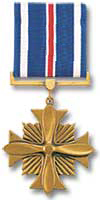 |
Distinguished Flying Cross
Awarded for actions during the World
War II
(Citation Needed) - SYNOPSIS: Major General Samuel
Egbert Anderson (ASN: 0-17244/92A), United States
Army Air Forces, was awarded the Distinguished
Flying Cross for extraordinary achievement while
participating in aerial flight.
Service: Army
Air Forces
Rank: Major
General
|
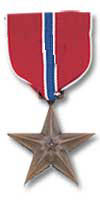 |
Bronze Star
Awarded for actions during the World
War II
The President of the United States of America takes
pleasure in presenting the Bronze Star Medal to
Major General Samuel Egbert Anderson (ASN:
0-17244/92A), United States Army Air Forces, for
meritorious service in connection with military
operations from March to 8 May 1945. As Commanding
General, 9th Air Division, General Anderson, by
outstanding knowledge of medium bombardment
operations, military acumen and skill, was eminently
responsible for the successful missions flown by
aircraft at the Division in the initial phase of the
Rhine River Crossings, as well as the sustained
success of subsequent medium bombardment operations
in the heart of the Rhineland. The superior
executive abilities, resourcefulness and tact,
exhibited by General Anderson throughout this period
were in keeping with the highest traditions of the
NINTH Army Air Forces.
Action Date: March
- May 8, 1945
Service: Army
Air Forces
Rank: Major
General |
 |
Army Distinguished Service Medal
The President of the United States of America,
authorized by Act of Congress July 9, 1918, takes
pleasure in presenting a Third Bronze Oak Leaf
Cluster in lieu of a Fourth Award of the Air Force
Distinguished Service Medal (Army Design) to General
Samuel Egbert Anderson (ASN: 0-17244/92A), United
States Air Force, for exceptionally meritorious and
distinguished service in a position of great
responsibility to the Government of the United
States, while serving as Air Deputy to the Supreme
Allied commander Europe, from 1 August 1961 to 31
July 1963. Serving in this post of international
significance for two years, General Anderson
contributed directly to the security of the United
States and its NATO Allies by his exceptional
performance of duty. In his capacity as principal
assistant and advisor to the Supreme Allied
Commander Europe in all military and
politico-military matters affecting the
organization, training, readiness and employment of
the multi-national air forces assigned to Allied
Command Europe, he demonstrated a high degree of
professional competence and leadership. His
coordination of plans for the support of Allied
Command Europe by the strategic air forces of the
United States and the United Kingdom reflected great
credit upon himself and the United States Air Force.
General Orders: Department
of the Air Force, General Orders No. G-100 (1963)
Action Date: August
1, 1961 - July 31, 1963
Service: Air
Force
Rank: General |
| Source: |
Military Times |
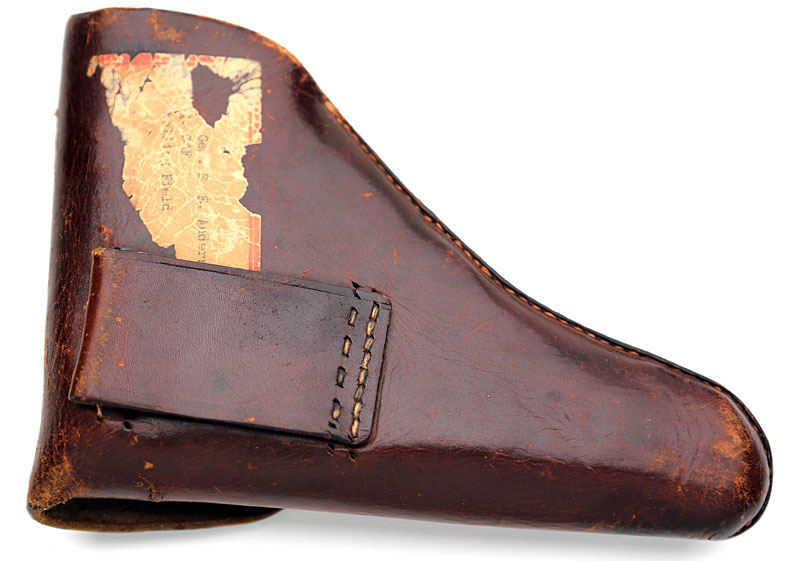
Holster (which looks like
it may be for a Walther PPK) accompanying General Anderson's
Colt 1908 Pocket Hammerless .380 ACP pistol.
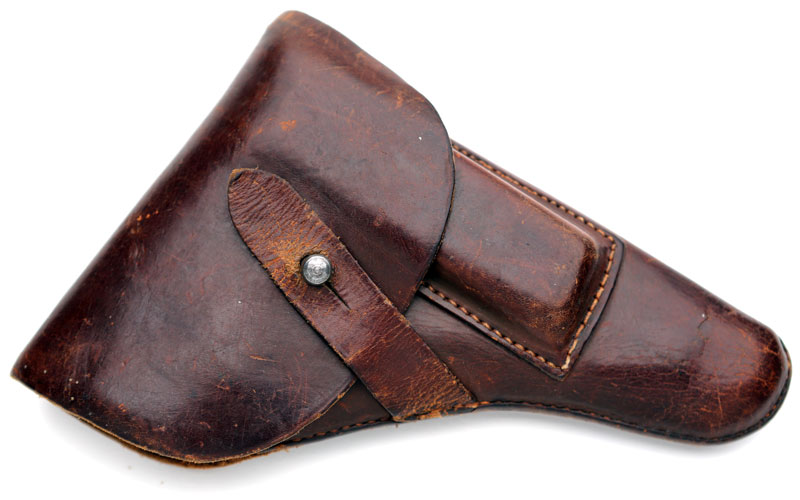
Holster accompanying General Anderson's
Colt 1908 Pocket Hammerless .380 ACP pistol. |